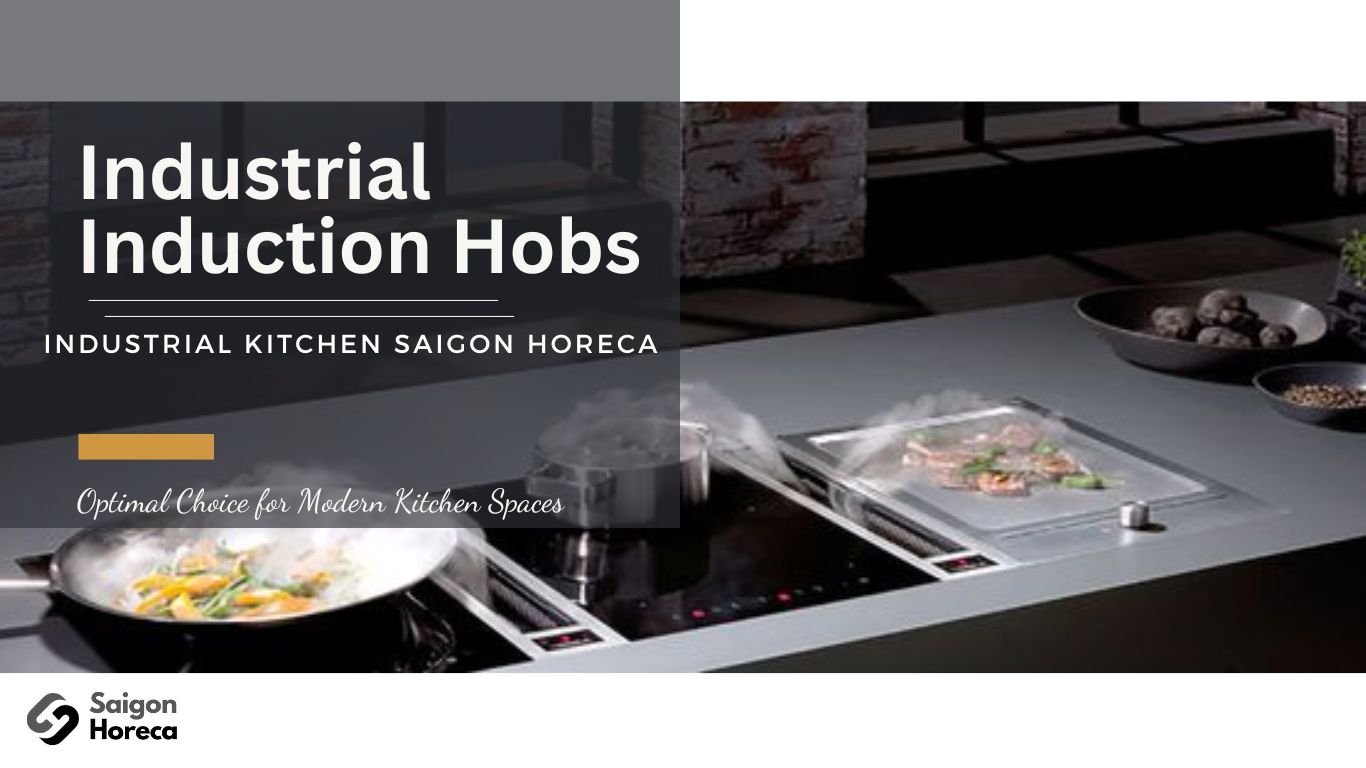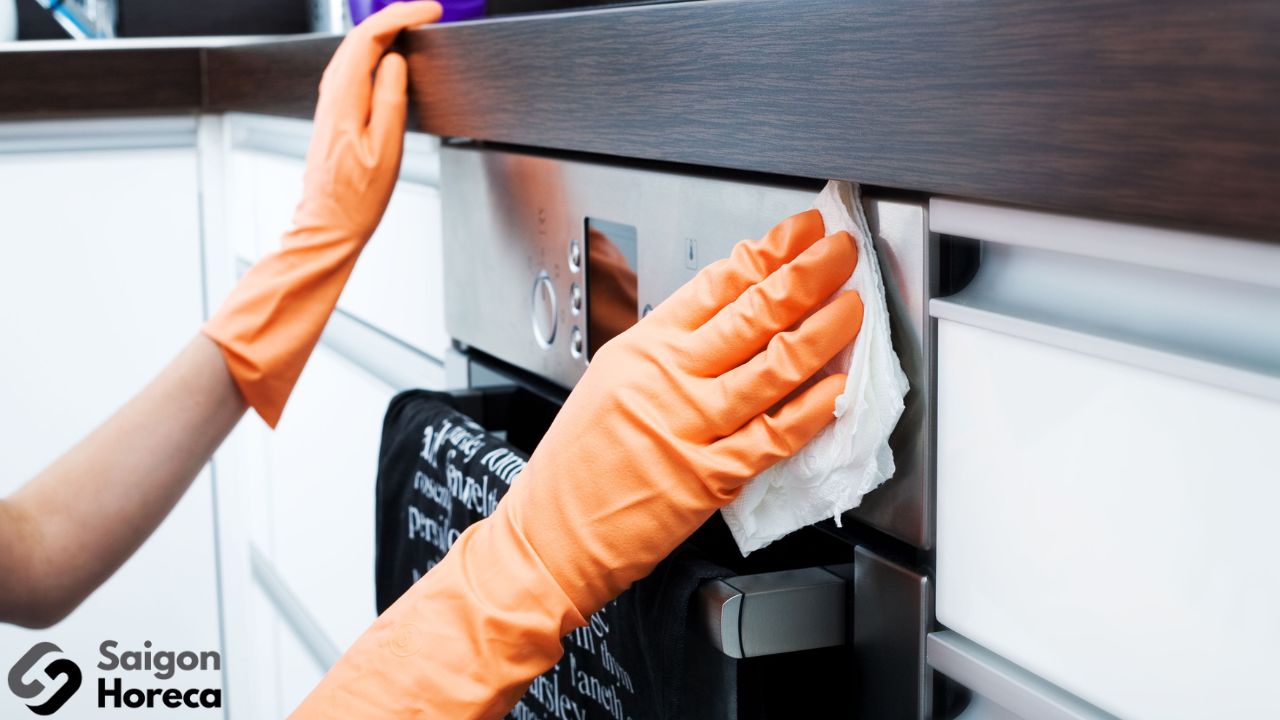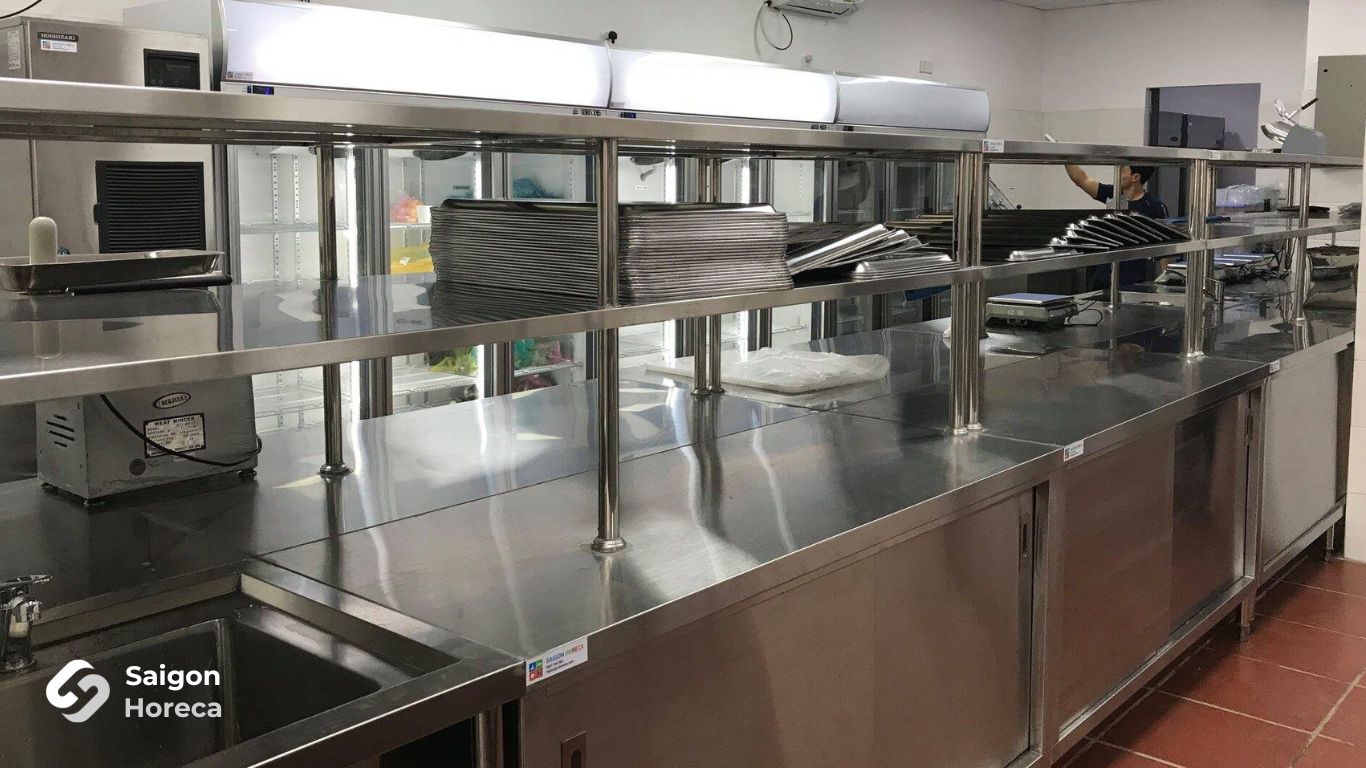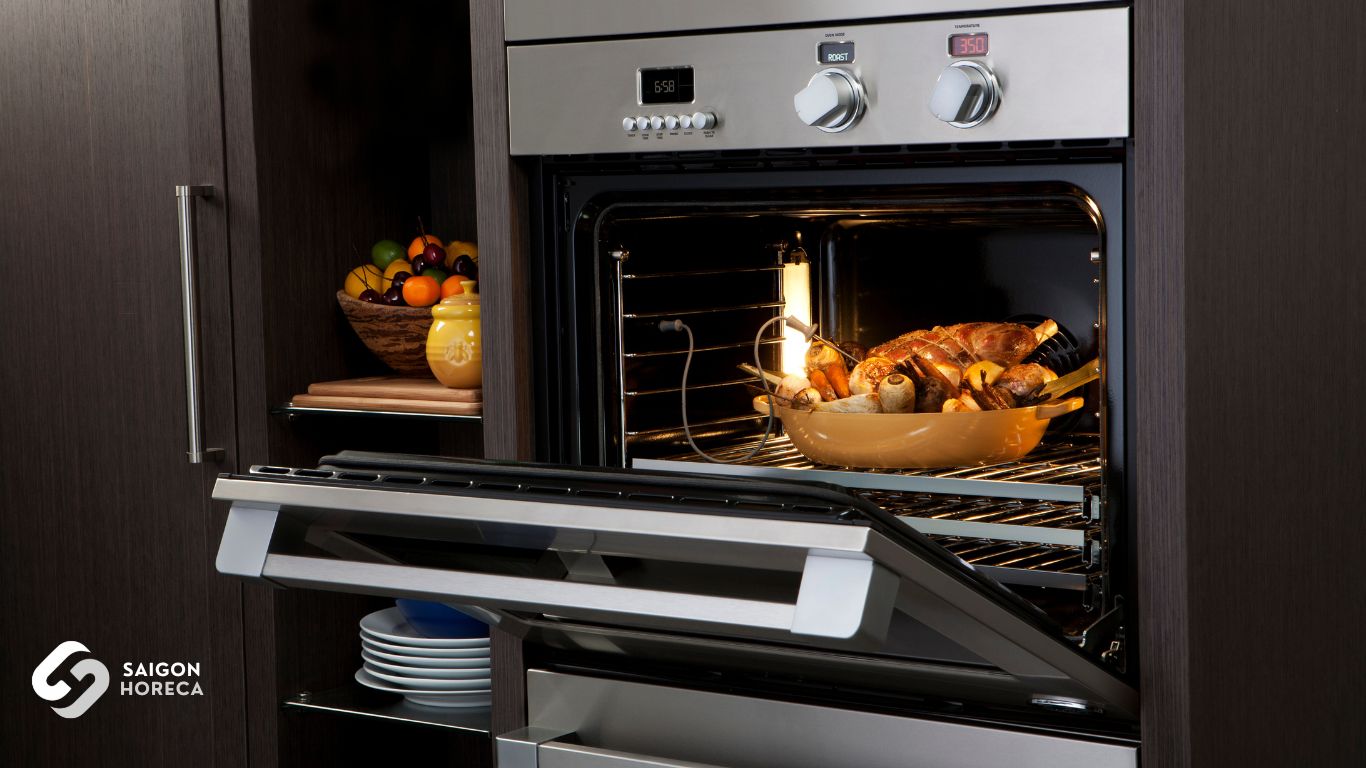In the context of the rapidly growing culinary and food service industry, investing in industrial kitchen equipment for a canteen […]
Read more

- Industrial Kitchen Equipment, Kitchen Equipment by Business Model
Industrial Induction Hobs: A Smart Choice for Culinary Businesses
- February 22, 2024
In today’s culinary industry, optimizing cooking processes and restaurant operations is key to success. With the continuous development of technology, industrial induction hobs have quickly become one of the most important tools in modern culinary enterprises. Their energy-saving capabilities, high efficiency, and flexibility are characteristic strengths of industrial induction hobs, helping businesses streamline cooking processes and enhance operational efficiency.
In this article, we will delve deeper into industrial induction hobs and why they are considered a smart choice for culinary businesses. We will explore the advantages and benefits that industrial induction hobs bring, as well as recognize the important role of this technology in improving service quality and optimizing operating costs for culinary enterprises.
Let’s dive in and explore how industrial induction hobs are changing the way the culinary industry operates today.
In this article
Exploring Industrial Induction Hobs: Uniqueness in Cooking
In the culinary world, industrial induction hobs have long asserted their top position thanks to their outstanding characteristics.
Operating on the principle of induction, industrial induction hobs use magnetic fields to convert electrical energy into heat. With the combination of advanced technology and design, industrial induction hobs are not just cooking tools but also symbols of modernity and convenience in food preparation.
In particular, industrial induction hobs are highly regarded for their ability to operate continuously and their powerful output, making them suitable for culinary establishments with the need to process large quantities of food. Compared to traditional gas hobs, induction hobs not only help minimize safety risks but also ensure a clean working environment, free from smoke and dust, and do not emit harmful gases, contributing to protecting the health of users and minimizing the impact on the surrounding environment.


Outstanding Features of Industrial Induction Hobs
In today’s market, there is a variety of industrial induction hobs available, including single hobs, double hobs, flat hobs, or 5kw power hobs, but they all share noteworthy common characteristics. Below are some common features of industrial induction hobs:
Construction Material
Industrial electric hobs are typically made from high-quality stainless steel, completely different from conventional hobs made from inferior materials. Thanks to stainless steel, induction hobs offer elegance and easy cleaning after use. The hob surface is made from heat and impact-resistant glass, preventing breakage during use.
Hob Surface
The hob surface is made from high-temperature and heavy-duty glass, with two main types: flat and concave, each with its own advantages. An intelligent electronic control panel is equipped on the hob surface, with simple control buttons such as on/off, temperature adjustment, and safety lock button, making it easy for users to control the cooking process.
Fuel Usage
Industrial induction hobs operate on the principle of converting electrical energy into heat energy, significantly saving fuel thanks to concentrating heat on the contact area with the cooking pot.
Control System
Industrial induction hobs are equipped with multiple control mode buttons on the surface, including a timer function, helping users save time and increase convenience during the cooking process. The control system is touch-controlled, bringing elegance and utility to users.
These features have made industrial induction hobs the top choice for restaurants, eateries, and culinary establishments with the need for efficient and safe processing of large quantities of food.


Structure and Operation of Industrial Induction Hobs
Industrial induction hobs play a crucial role in communal kitchens and kitchen areas of hotels and restaurants. The structure and operation of these hobs are based on the following principles:
1. Structural Components:
- Hob Body: Made of 1mm thick 304 stainless steel, ensuring durability and compliance with food safety standards.
- Induction Hob Surface: The most important part, made of high-quality toughened glass capable of withstanding temperatures up to 1000 degrees Celsius and strong pressure.
- Glass Surface: Glossy, not only protecting the hob body and internal components but also providing overall beauty to the product and easy cleaning after use.
- Magnetic Field Generating Equipment: Placed under the toughened glass surface, generating heat when electricity passes through, heating the food when the cooking pot is placed on it.
- Heat Dissipation Slots: CNC-cut around the hob body, helping the device operate stably and extend its lifespan.
- Cooling Fan: Cools down the internal components of the hob, helping balance the temperature inside and outside the environment, especially when the hob operates at high efficiency.
- Control Panel: Utilizes modern technology, adjusts the amplitude of alternating current and contains control components, LED display lights.
2. Operation:
When activated, the magnetic field generating equipment creates heat under the induction hob surface. This heats up the cooking pot placed on it, cooking the food. The cooling fan helps maintain the stable operating temperature of the hob and extends the device’s lifespan.
Based on this structure and operation, industrial induction hobs not only ensure high efficiency but also provide safety and convenience during use.
Operating Principle of Industrial Induction Hobs
Industrial induction hobs operate on the principle of magnetic field induction, where electric current is regulated through the hob’s induction coil to generate a magnetic field, thus heating the metal materials in pots, pans, and cookware.
1. Foucault Current:
- Foucault current is generated when the magnetic field interacts directly with the metal materials in the cookware.
- The bottom of the cookware acts as a coil with very low resistance, where electrons move at high speed, generating high temperatures and cooking the food.
- Eddy current path: This is the path through which the magnetic field from the induction coil transfers to the hob surface, creating Foucault currents.
2. Induction Coil (Copper Coil) Generating the Magnetic Field:
- The induction coil is placed under the glass surface of the hob and made of copper wires, with electric current passing through this coil to generate the magnetic field.
- The continuous transformation of the copper coil creates the necessary magnetic field to heat the materials in the cookware.
The induction hob device utilizes the principle of converting electrical energy into heat energy for cooking. To adjust the temperature, the hob controls adjust the intensity of the magnetic field under the cookware’s base by adjusting the power from low to high through the control knobs.


Comparison between Industrial Induction Hobs and Other Common Types of Stoves
The design of industrial induction hobs is a perfect blend of modernity, elegance, and sophistication, providing inspiration for chefs during their work. At the same time, this product line also contributes to creating a classy, modern kitchen space for businesses and investors.
The size and power of the hob are created according to the specific requirements of customers. Depending on the intended use, restaurant industrial hobs can be adjusted to serve various purposes such as boiling, steaming, frying, stewing, braising, or stir-frying. This helps optimize efficiency and meet the diverse needs of different culinary establishments.
Meeting Demand with Fast Cooking Speed
In industrial induction hobs, the ability to cook quickly to meet demands within a short period is extremely important. Especially when preparing multiple servings in a limited time while ensuring quality, industrial induction hobs are the optimal choice.
The cooking time on industrial induction hobs is extremely fast, helping quickly fulfill orders. However, it’s crucial that the hob maintains the necessary temperature to ensure the flavor and quality of the food. This is achieved through flexible and precise temperature adjustments, ensuring each dish is cooked evenly and deliciously.
Cost Optimization with Economic Efficiency
Industrial induction hobs not only save costs for investors in the long run but also ensure safety and economic efficiency.
Although the initial investment for equipping industrial induction hobs may be higher compared to gas-powered stoves, the long-term electricity consumption costs are often much lower. This brings significant economic benefits to businesses, optimizing costs and increasing profits.
Furthermore, induction hobs are safer than other energy-consuming stoves, reducing the risk of accidents and protecting the assets of the business. In summary, investing in industrial induction hobs not only brings convenience and efficiency in operation but also provides sustainable economic benefits for the business.



Flexibility in Mobility and Integration
Industrial induction hobs are specially designed to provide flexibility for users in movement and integration with other equipment.
With a lightweight and sturdy structure, induction hobs can be easily moved from one position to another without causing too much inconvenience. This helps to make the workspace in the kitchen more flexible, meeting specific requirements and situations during operations.
Furthermore, this flexibility allows induction hobs to easily integrate with other stainless steel equipment such as storage cabinets, cooking utensil racks, or dishwashing sinks. This integration not only optimizes space but also creates convenience and efficiency during use.
Energy Savings and Absolute Safety
Industrial induction hobs operate on the principle of electromagnetic induction, with Foucault currents generating heat directly into the pot base, without causing unnecessary heat consumption into the surrounding environment. This helps to keep the kitchen space cool, with a heat efficiency reaching over 90%, thereby minimizing electricity consumption while still ensuring cooking efficiency.
Moreover, with no gas usage and no flame generation, industrial induction hobs provide a level of safety almost absolute. There is no risk of gas cylinder explosions and minimal risk of burns due to the absence of flames. The hob’s power connection is equipped with a circuit breaker, automatically cutting off power in case of emergencies, enhancing safety for users.
Classification of the Most Preferred Industrial Induction Hobs Today
Currently, there are many industrial induction hob products available on the market from various manufacturers. Based on usage requirements, we can classify them into two common types of industrial induction hobs.
Single Industrial Induction Hobs
Single industrial induction hobs are designed with a large hob surface with high power, suitable for small to medium-scale restaurants, eateries, schools, or communal kitchens. This type of hob can operate independently or in combination with other equipment. The main function of single industrial induction hobs is cooking and food processing, similar to other types of industrial hobs, but with higher power to ensure work efficiency and serve more people.
Double Industrial Induction Hobs
Double industrial induction hobs have two large hob surfaces with high power, allowing for cooking and serving large quantities of food at the same time. With very high operating power and extremely efficient performance, double industrial induction hobs are suitable for large and medium-sized business models such as restaurants, hotels, communal industrial zones, food stores, and more. Additionally, double industrial induction hobs consume very low energy while still ensuring the serving of large food quantities, helping investors achieve high economic efficiency.
Depending on the characteristics of the hob surface, double industrial induction hobs are divided into two types: flat hob and concave hob.


Flat Industrial Induction Hobs
Flat induction hobs have a flat surface and are commonly used in restaurants, hotels, schools, and communal kitchens to serve large numbers of people. Similar to conventional hobs, flat induction hobs use electricity to save costs compared to gas hobs.
With a larger contact area between the cooking utensil and the hob surface, the cooking time for methods such as frying, stir-frying, sautéing, steaming, etc., is faster, and the food is cooked evenly and tastier.
Moreover, flat induction hobs are also manufactured and designed to serve households, ensuring safety, cleanliness in the kitchen area, and high work efficiency. This type of hob is designed to be used with flat-bottomed cookware, ensuring that the contact surface with the bottom of the cookware is 100%, optimizing and minimizing heat loss.
Concave Industrial Induction Hobs
Concave industrial induction hobs, also known as concave electric stir-fry hobs, are designed with a large contact area between the hob surface and the bottom of the pot, pan, or wok. Compared to flat induction hobs, concave hobs have depth, creating a space that envelops the bottom of the pot, enhancing contact and efficient heat transfer. This prevents heat from being lost to the surrounding environment, making it particularly suitable for preparing dishes such as boiling, soup-making, bone stewing, stir-frying, and many others.
With more contact, the heat emitted from the hob surface is efficiently absorbed by the bottom of the pot, ensuring even and faster cooking. This not only saves fuel but also enhances efficiency and convenience during use.
Single or double industrial induction hob models can also be designed with concave surfaces, allowing for direct cooking and food preparation on the hob surface without the need for cooking utensils such as pots, pans, or woks. This creates flexibility and convenience in use, especially in large or medium-sized business models.
Choosing Between Flat and Concave Industrial Induction Hobs
The decision between choosing a flat induction hob and a concave one is often a significant consideration for consumers when seeking the most suitable hob for their needs. Depending on the type of cuisine and business model, each type of hob will be suitable for different specific requirements.
Flat induction hobs are often preferred for preparing dishes such as frying, grilling, stir-frying, etc., thanks to their convenient and easy-to-use flat surface. On the other hand, concave induction hobs are more suitable for dishes that require boiling, stewing, or longer cooking times. However, this doesn’t mean that these types of hobs are not suitable for other dishes. Flat induction hobs can still be used for boiling, but they will consume more fuel compared to concave induction hobs.
Therefore, when choosing between flat and concave induction hobs, it is most important to consider your usage needs and business model. Only by understanding these factors can you choose the most suitable type of industrial induction hob for your business.








Criteria for Choosing the Right Industrial Induction Hob for Your Needs
Quality is the foremost factor that customers should consider when choosing any product. Typically, high-quality products are often associated with well-known and reputable brands.
- Ease of Use: Industrial induction hobs need to have high power output but should also be easy to operate, helping chefs save time and making usage more flexible.
- Price: For each specific usage requirement, customers need to be advised and provided with products with the most suitable power output and price range.
Choosing a suitable industrial induction hob not only ensures work efficiency but also helps optimize costs and enhance effectiveness in the cooking and serving process.
Important Notes for Using Industrial Induction Hobs
Below are some important notes for using industrial induction hobs safely and efficiently:- Placement: Place the induction hob in a well-ventilated area, away from other heat sources, and avoid placing it near walls to prevent accidents.
- Stable Power Supply: Ensure that the induction hob has a stable and dedicated power supply to avoid malfunctions during operation.
- Appropriate Cookware Type: Use the correct type of cookware with a flat bottom and made of good heat-conducting materials such as iron or stainless steel to achieve the best performance.
- Proper Shutdown: Do not abruptly turn off the power immediately after use; wait for the cooling fan to stop before turning off the power.
- Gentle Use of Cookware: Place cookware such as pots and pans on the hob gently to avoid spilling water onto the glass surface, which could damage it.
- Meal Preparation Planning: Prepare ingredients and cooking plans beforehand to avoid constantly turning the hob on and off, saving time and energy.
- Avoid Using Excessive Heat: Limit the use of excessively high temperatures for extended periods to protect the hob and ensure safety.
- Regular Cleaning: Use a clean, damp cloth to wipe the induction hob’s surface after each use to properly maintain and care for the product.






Tips for Choosing a Quality Industrial Induction Cooker
When you’re looking for a durable and reliable industrial induction cooker, here are some important tips to consider:
- Understand your usage needs: Clearly define the purpose of the cooker. Do you need it for a restaurant, hotel, or for household use? This will help you choose the most suitable cooker for your needs.
- Choose a reputable manufacturer: Research and select a manufacturer with a good reputation and experience in the production of industrial cookers. This ensures that you receive a quality and reliable product.
- Check the materials and durability: Ensure that the cooker is made from high-temperature resistant materials and has good durability. Thoroughly check the materials and durability of the product before making a purchase.
- Features and performance: Check features such as temperature control, power adjustment capability, and safety protection features. Choose a cooker with the best features and performance to meet your cooking needs.
- Evaluate value: Compare the price and value of the product. Choose a product that offers reasonable price and quality that suits you.
- Assess safety: Ensure that the product has safety features such as automatic shutdown function and overheat protection to protect users and prevent accidents.
- Read reviews and feedback: Before making a purchase, read reviews and feedback from other users to better understand the performance and quality of the product.
- Seek expert opinions: If you’re still unsure, seek the opinions of experts in the field to gain a comprehensive understanding and make the most informed choice.
These tips will help you choose a quality and reliable industrial induction cooker that meets your needs.
Guide to Maintenance and Cleaning of Large Capacity Induction Cookers
Proper maintenance and cleaning of industrial induction cookers are crucial to ensure their performance and longevity. Here are some basic guidelines:
- Clean the Cooktop Surface:
- Use a specialized glass cleaner to wipe the cooktop surface after each use.
- Avoid placing objects on the cooktop surface to maintain a clean and airy workspace.
- Avoid Using Sharp Objects:
- Do not use sharp objects or metal scouring pads to scrub the cooktop surface to prevent damage or scratches.
- Contact Technical Support in Case of Issues:
- If you notice any cracks, fractures, or warping on the cooktop surface, do not attempt to repair it yourself.
- Contact technical support for maintenance, servicing, and timely troubleshooting.
Adhering to these guidelines will help preserve and maintain industrial induction cookers in optimal working condition, thereby increasing their lifespan.


Where is the best place to buy industrial induction cookers?
To purchase high-quality and guaranteed industrial induction cookers, you can turn to Saigon Horeca. Saigon Horeca specializes in advising on industrial kitchen design and supplying industrial induction cooking equipment, serving restaurants, hotels, and other culinary establishments.
Products from Saigon Horeca, including single and double industrial induction cookers, are always ensured to have superior quality and safety when in use. Especially, prices are always reasonably guaranteed, fitting the needs and budgets of customers.
With comprehensive design consulting services and a commitment to product quality, Saigon Horeca is a reliable choice when you need to buy industrial induction cookers.
Monday - Friday
from 8h00 to 18h00
40 Street No. 6, Melosa Garden, Phu Huu District, HCMC
Contact anytime
Looking to elevate your grilled dishes with a Salamander Grill? With its ability to grill quickly and evenly while giving […]
Read more




